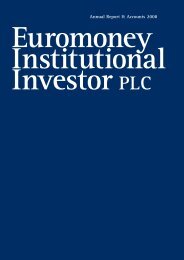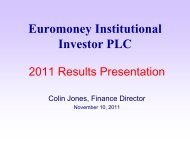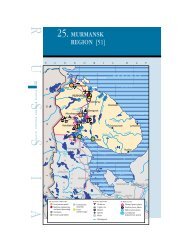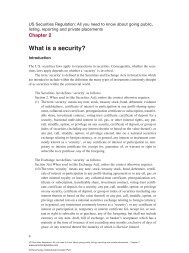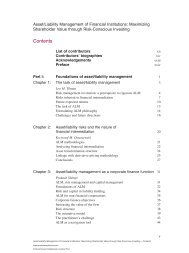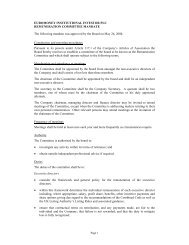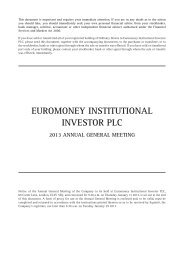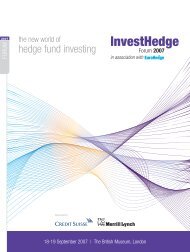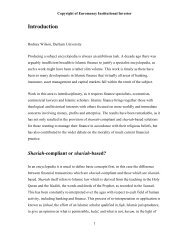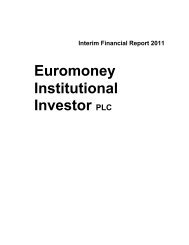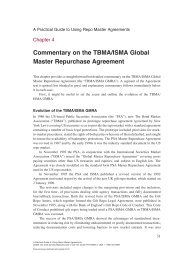Annual Report & Accounts 2012 - Euromoney Institutional Investor ...
Annual Report & Accounts 2012 - Euromoney Institutional Investor ...
Annual Report & Accounts 2012 - Euromoney Institutional Investor ...
Create successful ePaper yourself
Turn your PDF publications into a flip-book with our unique Google optimized e-Paper software.
<strong>Euromoney</strong> <strong>Institutional</strong> <strong>Investor</strong> PLC <strong>Annual</strong> <strong>Report</strong> and <strong>Accounts</strong> <strong>2012</strong><br />
www.euromoneyplc.com<br />
Our Performance<br />
1 Accounting policies continued<br />
Financial liabilities<br />
Committed borrowings and bank overdrafts<br />
Interest-bearing loans and overdrafts are recorded at the amounts<br />
received, net of direct issue costs. Direct issue costs are amortised over the<br />
period of the loans and overdrafts to which they relate. Finance charges,<br />
including premiums payable on settlement or redemption are charged to<br />
the Income Statement as incurred using the effective interest rate method<br />
and are added to the carrying value of the borrowings or overdraft to the<br />
extent they are not settled in the period in which they arise.<br />
Trade payables<br />
Trade payables are not interest-bearing and are stated at their fair value.<br />
Derivative financial instruments<br />
The group uses various derivative financial instruments to manage its<br />
exposure to foreign exchange and interest rate risks, including forward<br />
foreign currency contracts and interest rate swaps.<br />
All derivative instruments are recorded in the balance sheet at fair value.<br />
The recognition of gains or losses on derivative instruments depends on<br />
whether the instrument is designated as a hedge and the type of exposure<br />
it is designed to hedge. The group designates certain derivatives as either:<br />
(a) hedges of a particular risk associated with a recognised asset or<br />
liability or a highly probable forecast transaction (cash flow hedge);<br />
or<br />
(b) hedges of a net investment in a foreign operation (net investment<br />
hedge).<br />
The group documents at the inception of the transaction the relationship<br />
between hedging instruments and hedged items, as well as its risk<br />
management objectives and strategy for undertaking various hedging<br />
transactions. The group also documents its assessment, both at hedge<br />
inception and on an ongoing basis, of whether the derivatives that are<br />
used in hedging transactions are highly effective in offsetting changes in<br />
fair values or cash flows of hedged items.<br />
The full fair value of a hedging derivative is classified as a non-current<br />
asset or liability when the derivative matures in more than 12 months,<br />
and as a current asset or liability when the derivative matures in less than<br />
12 months. Trading derivatives are classified as a current asset or liability.<br />
Cash flow hedge<br />
The effective portion of gains or losses on derivatives that are designated<br />
and qualify as cash flow hedges are recognised in other comprehensive<br />
income within the Statement of Comprehensive Income. The ineffective<br />
portion of such gains and losses is recognised in the Income Statement<br />
immediately.<br />
Amounts accumulated in equity are reclassified to the Income Statement in<br />
the periods when the hedged item is recognised in the Income Statement<br />
(for example, when the forecast transaction that is hedged takes place).<br />
The gain or loss relating to the effective portion of interest rate swaps<br />
hedging variable rate borrowings is recognised in the Income Statement<br />
accordingly, the gain or loss relating to the ineffective portion is recognised<br />
in the Income Statement immediately. However, whenever the forecast<br />
transaction that is hedged results in the recognition of a non-financial<br />
asset (for example fixed assets), the gains and losses previously deferred in<br />
equity are transferred from equity and included in the initial measurement<br />
of the cost of the asset. The deferred amounts are ultimately recognised<br />
in depreciation in the case of fixed assets.<br />
When a hedging instrument expires or is sold, or when a hedge no longer<br />
meets the criteria for hedge accounting, any cumulative gain or loss<br />
existing in equity at that time remains in equity and is recognised when<br />
the forecast transaction is ultimately recognised in the Income Statement.<br />
When a forecast transaction is no longer expected to occur, the cumulative<br />
gain or loss that was reported in equity is immediately transferred to the<br />
Income Statement.<br />
The premium or discount on interest rate instruments is recognised as part<br />
of net interest payable over the period of the contract. Interest rate swaps<br />
are accounted for on an accruals basis.<br />
Net investment hedge<br />
Hedges of net investments in foreign operations are accounted for in the<br />
same way as cash flow hedges.<br />
Gains or losses on the qualifying part of net investment hedges are<br />
recognised in other comprehensive income together with the gains and<br />
losses on the underlying net investment. The ineffective portion of such<br />
gains and losses is recognised in the Income Statement immediately.<br />
Changes in the fair value of the derivative financial instruments that do<br />
not qualify for hedge accounting are recognised in the Income Statement<br />
as they arise.<br />
Gains and losses accumulated in equity are transferred to the Income<br />
Statement when the foreign operation is partially disposed of or sold.<br />
Liabilities in respect of put option agreements<br />
Liabilities for put options over the remaining minority interests in<br />
subsidiaries are recorded in the Statement of Financial Position at their<br />
estimated discounted present value. These discounts are unwound and<br />
charged to the Income Statement as notional interest over the period up<br />
to the date of the potential future payment.<br />
Notes to the Consolidated Financial Statements<br />
Company <strong>Accounts</strong> Group <strong>Accounts</strong> Our Governance<br />
67



